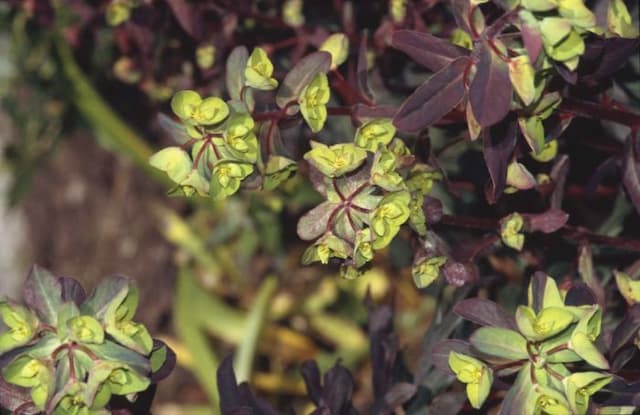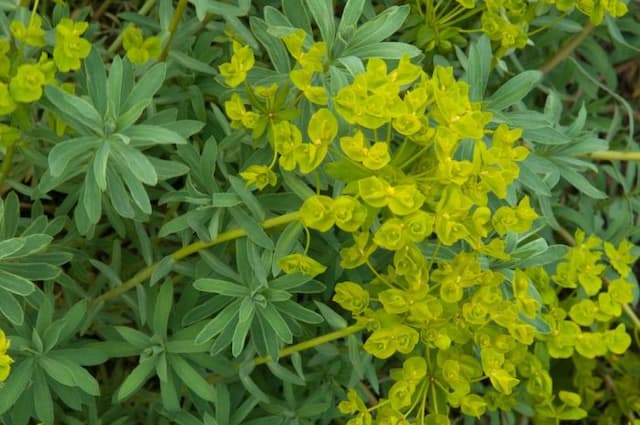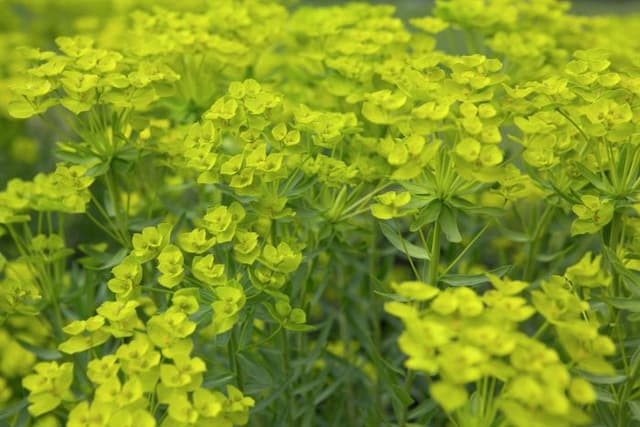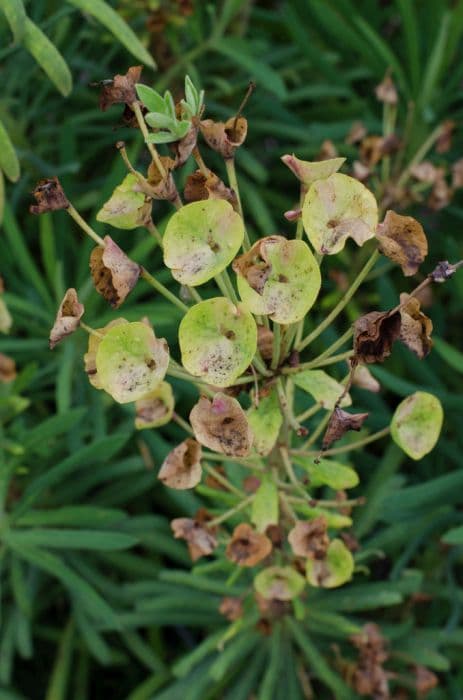Castor bean Ricinus communis 'Impala'

ABOUT
The 'Impala' variety of castor bean plant is distinguished by its striking, bold foliage and attractive seed pods that make it a popular choice for ornamental planting. Its leaves are large, with a glossy surface and a deep, rich burgundy red color that can appear almost black in certain light conditions. Each leaf is palmate, meaning it is shaped like an open hand, with a central point from which multiple pointed lobes radiate outward, giving it a star-like appearance. The stems of the castor bean 'Impala' are sturdy and share the same deep red to purplish hue as the leaves, creating a cohesive look throughout the plant. Throughout the growing season, the plant produces clusters of small, inconspicuous flowers that may be followed by spiky seed pods. These seed pods have a unique, textured appearance and are often valued in the plant's ornamental display. The seeds within the pods are shiny and bean-like, with mottled patterns that can be quite striking. However, it's important to note that the seeds are highly toxic if ingested. The ornamental attributes of the castor bean 'Impala' make it a dramatic and eye-catching addition to gardens where a strong visual impact is desired.
About this plant
 Names
NamesFamily
Euphorbiaceae.
Synonyms
Castor Bean, Castor Oil Plant, Palma Christi, African Coffee Tree.
Common names
Ricinus communis 'Impala'.
 Toxicity
ToxicityTo humans
Castor bean, the common name for Ricinus communis 'Impala', is highly poisonous to humans if ingested. The seeds contain the toxin ricin, one of the deadliest naturally occurring substances. Even a small amount, equivalent to one or two seeds, can be lethal if chewed and swallowed. Symptoms of ricin poisoning can occur within a few hours to several days and include abdominal pain, vomiting, diarrhea, which may become bloody, severe dehydration, and a decrease in urine. If untreated, the condition can lead to severe dehydration, multiple organ failure, and death. There is no antitoxin for ricin, and treatment involves supportive care to manage symptoms.
To pets
Castor bean, the common name for Ricinus communis 'Impala', is also highly toxic to pets, including dogs and cats. The seeds of the plant contain ricin, a potent toxin. Ingesting even a single seed can result in severe poisoning for a small animal. Symptoms of poisoning in pets are similar to those in humans, including loss of appetite, excessive thirst, weakness, colic, trembling, sweating, loss of coordination, difficulty breathing, seizures, and in severe cases, death due to multiple organ failure. Immediate veterinary attention is required if a pet has ingested any part of the castor bean plant.
 Characteristics
CharacteristicsLife cycle
Annuals
Foliage type
Deciduous
Color of leaves
Dark red
Flower color
Varies
Height
6-10 feet (1.8-3.0 meters)
Spread
2-3 feet (0.6-0.9 meters)
Plant type
Shrub
Hardiness zones
9
Native area
Africa
Benefits
 General Benefits
General Benefits- Ornamental Appeal: The 'Impala' variety of Castor Bean Plant is known for its striking foliage and seed pods, which add a dramatic touch to gardens.
- Drought Tolerance: Once established, it has a good level of drought resistance, making it suitable for drier climates.
- Fast Growth: The plant grows rapidly, providing quick results for landscapers or gardeners looking for fast-developing greenery.
- Erosion Control: Its robust root system can help to stabilize soil and control erosion.
- Wildlife Attraction: It can attract pollinators such as bees, which are beneficial for the garden ecosystem.
- Shade Creation: With its large leaves, the Castor Bean Plant can provide shade for smaller plants or create a cooler microclimate within gardens.
- Privacy Screen: Due to its height and dense foliage, it can be used to create a natural privacy screen.
- Soil Conditioning: The plant is often used in crop rotations to help break up compact soils and add organic matter.
 Medical Properties
Medical Properties- Laxative: The seed oil of Ricinus communis is known to have a strong laxative effect.
- Anti-inflammatory: It has been used to reduce inflammation when applied externally.
- Antimicrobial: The plant has antimicrobial properties that have been observed in scientific studies.
- Analgesic: Compounds found in the plant may have pain-relieving effects.
 Air-purifying Qualities
Air-purifying QualitiesThis plant is not specifically known for air purifying qualities.
 Other Uses
Other Uses- Ricinus communis, also known as castor bean or castor oil plant, can be utilized as a natural fence due to its fast growth and dense foliage which creates a visual barrier.
- The plant's thick and large leaves are sometimes used in flower arrangements as a bold and dramatic foliage contrast.
- In some cultures, the stems of the castor oil plant are used in the production of sturdy, though temporary, baskets and containers.
- Its vibrant foliage can be planted in gardens to provide aesthetic appeal and structure due to its distinctive leaf shape and color.
- The castor oil plant's wood is occasionally used as a fuel source, although this is not common due to its lower calorific value.
- Castor meal, the by-product after oil extraction, is employed as a natural fertilizer for its high nitrogen content.
- The plant is sometimes cultivated for ornamental purposes in theme gardens, such as 'poison gardens' showcasing various toxic plants, due to its toxic properties.
- In some regions, the castor oil plant is used in erosion control projects because it establishes quickly and can stabilize soil with its extensive root system.
- The seeds, resembling ticks, have sometimes been used in jewelry making and decorative arts, but extreme caution is exercised due to their toxic ricin content.
- Some farmers plant castor beans amongst other crops as a form of biological pest control, taking advantage of the plant's natural repellent properties.
Interesting Facts
 Feng Shui
Feng ShuiThe Castor Bean plant is not used in Feng Shui practice.
 Zodiac Sign Compitability
Zodiac Sign CompitabilityThe Castor Bean plant is not used in astrology practice.
 Plant Symbolism
Plant Symbolism- Power: The 'Impala' variety of Castor Bean plant boasts strikingly bold foliage and vibrant hues, which are often associated with strength and dominance in nature.
- Protection: Traditionally, some cultures have used the Castor Bean plant to ward off evil, due to its toxic properties, as a natural form of protection.
- Uncertainty and Caution: Since Ricinus communis is known to be highly toxic, it can symbolize the need for caution and wariness of potential dangers.
- Healing: Despite its toxicity, Castor Oil, derived from the plant, is known for its medicinal qualities, symbolizing healing and therapeutic benefits.
 Water
WaterCastor bean plants, including 'Impala', prefer consistent moisture and should be watered deeply when the top inch of soil feels dry to the touch. This may mean watering once a week, but frequency can vary based on climate, weather, and soil type. In hot and dry weather, you might need to water more frequently. Provide enough water to moisten the soil to a depth of 6 to 8 inches. Adult plants typically require about 1 to 1.5 gallons of water per week, but always check the soil moisture level before watering to avoid overwatering.
 Light
LightCastor bean plants thrive in full sunlight, needing a minimum of six hours of direct sunlight per day. Hence, the best spot for 'Impala' would be a location that receives unobstructed sunlight for most of the day. They can tolerate partial shade, but their growth and foliage color are much more impressive in full sun.
 Temperature
TemperatureCastor bean plants grow best in temperatures ranging from 60°F to 85°F. 'Impala' can tolerate a minimum temperature of around 35°F, but growth will be stunted, and frost can kill the plant. Therefore, always ensure the plant is kept in conditions above 35°F and below around 90°F, which is the maximum temperature for optimal growth without heat stress.
 Pruning
PruningPruning castor bean 'Impala' helps maintain the plant’s shape, encourage bushier growth, and remove any damaged or diseased stems. Pruning should be done in the spring or early summer when the plant is actively growing. Cut back to just above a leaf node, and avoid excessive pruning to prevent stress to the plant.
 Cleaning
CleaningAs needed
 Soil
SoilCastor bean 'Impala' thrives in rich, well-draining soil with a pH between 6.0 and 7.0. A mixture of loamy garden soil, peat, and sand or perlite is ideal, ensuring good drainage and fertility. Regular amendments with compost will benefit the plant's growth.
 Repotting
RepottingCastor bean 'Impala' should be repotted every 1-2 years, or when the plant outgrows its container, to ensure it has enough room to grow and receive necessary nutrients.
 Humidity & Misting
Humidity & MistingCastor bean 'Impala' prefers moderate to high humidity levels but is quite adaptable to less humid conditions as long as its soil moisture is maintained.
 Suitable locations
Suitable locationsIndoor
Place in bright, indirect light and water regularly.
Outdoor
Plant in full sun, shelter from wind, and water generously.
Hardiness zone
9-11 USDA
 Life cycle
Life cycleCastor bean 'Impala' (Ricinus communis 'Impala') begins its life cycle as a seed, which germinates in warm, moist soil, typically within a week or two. Following germination, a seedling emerges with two cotyledons, and true leaves develop as the plant enters the vegetative growth stage. The plant grows rapidly under favorable conditions into a large, shrubby perennial, although it is often grown as an annual in temperate climates. As it matures, the Castor bean 'Impala' produces spiky flower clusters followed by seed pods; the plant is monoecious, with separate male and female flowers. Once the seed pods mature, they dry and split open, releasing seeds that can be collected for replanting. The life cycle is completed when the plant dies back after frosts or prolonged dry periods, or it may last several years in frost-free climates if conditions allow.
 Propogation
PropogationPropogation time
Spring-Summer
The most popular method of propagating the castor bean plant (Ricinus communis 'Impala') is through its seeds. Seed propagation is generally done in the spring after the danger of frost has passed and the soil has warmed up. The seeds, which are quite large, should first be soaked in water for 24 hours to enhance germination. After soaking, the seeds can be sown directly into the ground or into pots filled with a well-draining soil mix, placing them at a depth of about 1 inch (2.54 cm). They require a sunny location and consistent moisture to germinate, which usually occurs within 2 to 3 weeks. Once seedlings have emerged and grown strong enough, thinning may be necessary if they are too crowded, or transplanting can be carried out if they were started in pots.









